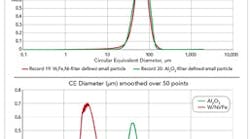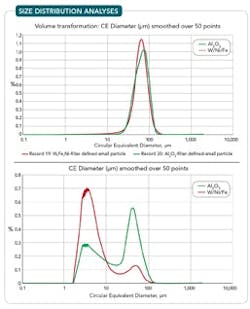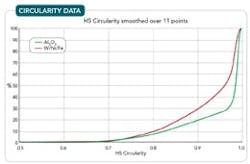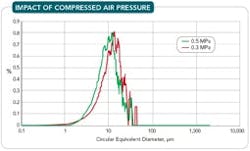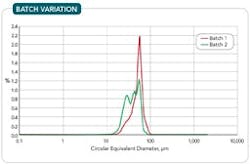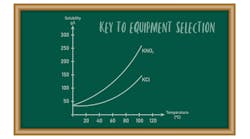Automated Imaging Optimizes Spray Drying Processes
Spray drying processes can deliver particles with precisely controlled size and shape, making the processes extremely valuable for the manufacture of a wide range of products. Selecting, designing and optimizing equipment to meet application-specific needs is crucial for success.
Preci Co., Ltd., Tokyo — a process engineering company with cutting-edge spray drying technology that supplies customers in chemical, pharmaceutical and other industries, and also does toll manufacturing — uses particle size and shape data to optimize its spray drying processes. Preci relies on measurements from a Morphologi G3 automated imaging system from Malvern Instruments, Malvern, U.K. Case study data we’ll discuss show how imaging can facilitate tuning process variables to meet requirements and ensure exemplary quality control.
[callToAction ]
The Merits Of Spray Drying
In the technique, liquid is sprayed or atomized into a drying chamber in which air (or an inert gas) drives off the solvent, typically water. The resultant dry material is then classified to give a product of closely defined particle size distribution.
Spray drying processes:
• make highly spherical particles with excellent flow properties (fluidity);
• operate continuously; and
• deliver particles/granules with a sharp, stable and closely defined particle size distribution.
These benefits have led manufacturers in many industries to adopt spray drying to make a wide variety of products. Ensuring the desired properties of these materials requires choosing the appropriate atomization technology and optimizing a range of process parameters.
Figure 1. Volume-based particle-size-distribution data (upper graph) suggest two materials are similar but number-based distribution (lower graph) shows a much higher level of fines in the W/Ni/Fe sample.
Preci offers various types of state-of-the-art atomization technology. Core designs include:
Rotary atomizer. A rotating disc applies shear to break up the liquid solution. Droplet size is controlled by the shape and design of the disc and, once that design is fixed, by varying the speed of rotation. This technology especially suits making particles in the 20–200-µm size range; compared with alternatives, it produces particles with higher sphericity and narrower particle size distributions.
Two-fluid nozzle. Here, the energy for atomization comes from the flow of compressed gas, which is used to drive two-phase flow through and from the nozzle. Manipulating compressed gas pressure (flow rate) controls droplet size. Two-fluid nozzles can produce very fine particles, from around 1 to 20 µm, and offer a relatively small footprint process. However, they require a ready supply of large quantities of compressed gas for operation.
Pressure nozzle. Forcing the liquid through one or more orifices under high pressure causes atomization. This simple design features low operating costs and provides significant scope, via orifice selection, to vary the size of granules produced.
Besides atomization technique, the specifics of the liquid solution/slurry determine process performance and the properties of the resulting granules. Key characteristics here include concentration, viscosity, specific gravity, additive content/inclusion (composition) and primary particle size distribution (the dispersion/aggregation state of particle in the feed solution). In addition, adjusting the inlet and outlet temperature of the dryer, the feed rate of the liquid and the airflow rate through the dryer can alter granule properties. Timely and informative particle characterization drives the comprehensive optimization of this web of interacting process parameters.
Better Analysis
The shape of granules produced by spray drying plays a vital role in defining their value. These particles generally are more spherical in shape — and thus flow more easily — than those of equivalent size produced by alternative means. As a result, the optimization of spray drying processes calls for analytical technology that offers both size and shape measurement.
Traditionally, Preci applied microscopy techniques to assess size and shape. However, this is a manually intensive and potentially subjective approach. Furthermore, the practicalities of analysis mean that relatively few particles are measured, potentially compromising the statistical significance of the resulting data. In 2012, the company decided to upgrade its analytical capabilities and invested in the Morphologi G3 automated imaging system.
The system captures images of tens of thousands of individual particles in a matter of minutes. The dimensions of each particle are used to generate number-based distributions of particle size and shape parameters, including circular equivalent diameter (CED) and circularity. CED is the diameter of a sphere with the same two-dimensional area as the particle. Circularity quantifies how close a particle is to being absolutely spherical; particles with a value near 1 are highly spherical while those with a value near 0 are far less regular in shape.
The key advantages of automated imaging from Preci’s perspective were that it provided statistically significant size and shape measurement via automated procedures that required minimal manual input. In addition, the new system produced databases of particle images that demonstrated the exemplary performance of Preci’s technology and toll-manufacturing operation to customers.
Figure 2. Al2O3 sample contains larger, more-regular particles than W/Ni/Fe sample.
Important Insights
The following three case studies illustrate some of the research the company has been able to implement following its adoption of automated imaging technology.
1. Optimizing the properties of ceramic granules. Most ceramic products, from bowls to intricate electronic components, are made by pressing ceramic powders into a mold and then firing the resulting “green body” to produce a finished, sintered component. Spray drying is used to convert ceramic slurries into granules that will perform well in this process. Finer powders pack densely in the mold, thereby reducing shrinkage when the component is fired, which is a positive feature. However, they also tend to exhibit poor flowability and are prone to segregation, which can be a problem for multicomponent ceramic mixtures incorporating additives. Spray drying pre-blended slurry avoids this latter issue. Particle size and shape also influence the mechanical properties of the green body and the fluidity and malleability of the final product. Establishing correlations between size and shape parameters supports the manufacture of higher quality ceramics.
Two ceramic test samples were prepared using a spray dryer: one made from Al2O3, the other from W/Ni/Fe. The two samples were produced nominally to the same particle size under identical spray drying conditions, and subsequently were analyzed by the Morphologi G3 using a standard operating procedure and automated sample dispersion unit. Number-based particle size and shape distributions were generated for both samples, with shape data generated only for those particles with a CED > 10 µm, to conduct a shape comparison on particles of the same size.
Figure 1 shows volume- and number-based particle size distributions for both samples. The volume-based size distribution suggests the samples are closely similar, but the greater sensitivity to fines of the number-based distribution indicates higher levels of material in the sub-10-µm region in the W/Ni/Fe sample: 79.2% for the W/Ni/Fe sample compared with an equivalent figure of 37.6% for the Al2O3.
Circularity data for the two samples (Figure 2) reveal the Al2O3 sample contains more circular particles than the W/Ni/Fe sample. Images of particles from both samples confirm the data and show the W/Ni/Fe particles to be both smaller and less regular.
These results suggest that, despite consistent spray drying conditions, the finished powders have different particle morphology. While further studies are required to fully explain the reasons for this, factors such as the properties of the feed slurry, its viscosity, composition or interfacial characteristics may well contribute to the observed differences. From the perspective of product performance, the Al2O3 sample would exhibit greater flowability when used to manufacture ceramic materials compared with the W/Ni/Fe alternative, and produce a finished component of higher malleability.
2. Investigating the impact of process parameters. With appropriate analytical information at hand, it is relatively straightforward to carry out simple trials to quantify the impact of the processing parameters outlined above. Figure 3 shows the results of an experiment to find the impact of changing compressed air pressure in a two-fluid nozzle on the production of Al2O3 granules. Here, reducing the pressure to 0.3 MPa from 0.5 MPa causes the median particle size (Dv50) of the granules to increase to 12 µm from 9 µm. A second experiment explored the effect of changing the concentration of the stock solution, which is the initial feed to the process; it showed that more concentrated solutions produce finer granules. These experiments indicated the size of droplets produced during atomization, and hence resulting particle size, is a function of the atomization pressure applied and the properties of the feed slurry, most especially viscosity. Viscosity determines the response of the liquid feed to the shear applied by the nozzle.
A later experiment showed how changing the temperature profile across the dryer impacts the size of the Al2O3 granules produced, with lower temperature yielding larger particles.
Figure 3. Reducing the pressure to 0.3 Mpa from 0.5 MPa causes an increase in median particle size of granules.
During the spray drying process, the feed slurry loses liquid via vaporization at a rate that is temperature dependent. At high temperatures, vaporization rates can be so great that the forming particles/droplets “explode,” resulting in fine particles with relatively irregular morphology. This effect would explain the finer particle size distribution observed at the higher drying temperature. Upon exiting the spray dryer, the particles pass through a cyclone collector that preferentially retains particles towards the finer end of the distribution. Thus, greater production of finer particles directly relates to a decrease in yield, as observed. Together, these effects indicate that the higher operating temperature is less optimal than the lower alternative, all other conditions being constant.
Such simple studies facilitate identifying optimal conditions for the efficient production of granules of a defined size. Furthermore, combining particle size data with other process observations generates enhanced process understanding.
3. Troubleshooting to enhance reproducibility. Because spray dried materials are prized for their precisely defined properties, reproducibility is critical. Figure 4 shows data for two batches produced under identical conditions. Their particle size distributions differ significantly, with Dv50s of 52µm and 39µm, respectively, and fall outside the reproducibility limits imposed by Preci for this application.
An investigation uncovered the reasons for the disparate results from the dryer. Although the stock solutions for both batches were produced by milling for the same period of time using identically sized balls within the mill, the ball-mill media material and weight were changed between the two runs (from 3-g zirconia balls to 2-g alumina ones). This led to a substantial difference in the viscosity of the two stock solutions that then went on to impact the size of finished spray dried granules. Establishing control over the ball-mill charge conditions corrected this issue and delivered the reproducibility required.
Figure 4. Difference in particle size distribution between batches fell outside of established reproducibility criteria.
Substantial Impact
Access to statistically significant particle size and shape data via automated imaging has enhanced Preci’s ability to meet customer requirements, either through the selection of processing equipment well-matched to the application and associated process optimization, or through exemplary toll manufacture. It has especially benefited the company’s ability to win toll manufacturing business, with customers welcoming the opportunity to view images of the high quality granules produced.
Spray-dried granules are prized for their shape, fluidity and tight particle-size distribution. Automated imaging data support the optimization of processes to robustly meet these expectations. Other techniques, including online laser diffraction technology for real-time particle sizing, also can be helpful. Preci continues to investigate technologies such as these to ensure its operations remain at the cutting edge of spray drying performance.
HAYATO KATO is chief executive officer of Preci Co., Ltd., Tokyo. SHINYA KAWAGUCHI is application and marketing manager, and YUICHI MISUMI is an application specialist for Preci in Kanagawa, Japan. DAISUKE SASAKURA is a product specialist for Malvern Instruments in Kobe, Japan. E-mail them at [email protected], [email protected], [email protected] and [email protected].
